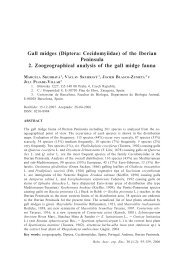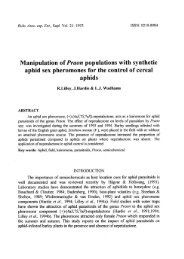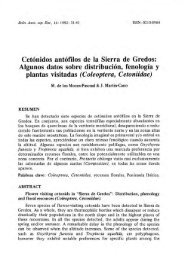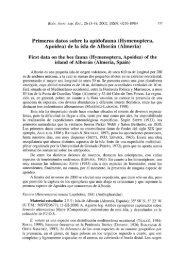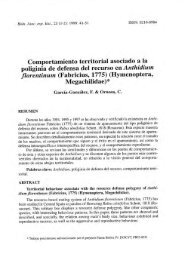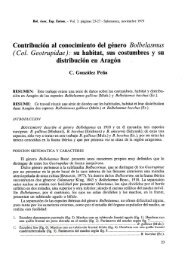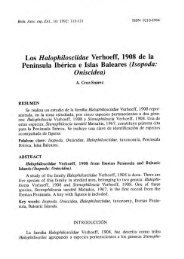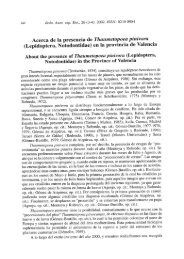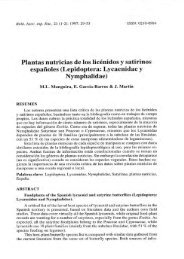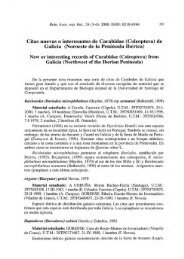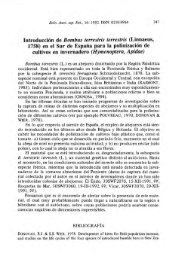Esfécidos de la provincia de Alicante (Hymenoptera: Sphecidae)
Esfécidos de la provincia de Alicante (Hymenoptera: Sphecidae)
Esfécidos de la provincia de Alicante (Hymenoptera: Sphecidae)
You also want an ePaper? Increase the reach of your titles
YUMPU automatically turns print PDFs into web optimized ePapers that Google loves.
Boln. Asoc. esp. Ent,, 17 (2): 1993: 9-25 ISSN: 0210-8984<br />
<strong>Esfécidos</strong> <strong>de</strong> <strong>la</strong> <strong>provincia</strong> <strong>de</strong> <strong>Alicante</strong><br />
(<strong>Hymenoptera</strong>: <strong>Sphecidae</strong>)<br />
S.G. Torregrosa, S.F. Gayubo, J. Tormos & J.D. Asís<br />
RESUMEN<br />
En este artículo se exponen datos re<strong>la</strong>tivos al estudio <strong>de</strong> material<br />
esfecidológico colectado, durante los últimos diez años, en <strong>la</strong> <strong>provincia</strong> <strong>de</strong><br />
<strong>Alicante</strong>. Se amplían <strong>de</strong> este modo, los conocimientos sobre <strong>la</strong> distribución<br />
geográfica y biología (p<strong>la</strong>ntas y tipos <strong>de</strong> terreno frecuentados por los imagos)<br />
<strong>de</strong> <strong>la</strong>s 118 especies y subespecies mencionadas. Solierel<strong>la</strong> verhoeffi Beaumont<br />
se cita por primera vez para <strong>la</strong> Penínsu<strong>la</strong> Ibérica.<br />
Pa<strong>la</strong>bras c<strong>la</strong>ve: <strong>Sphecidae</strong>, faunística, España.<br />
ABSTRACT<br />
Sphecid wasps of <strong>Alicante</strong> province (<strong>Hymenoptera</strong>: <strong>Sphecidae</strong>).<br />
In this paper the results of a study of the sphecidological material collected<br />
during the <strong>la</strong>st ten years in the <strong>Alicante</strong> province (east of Spain) are presented.<br />
Data on geograpical distribution and biology (p<strong>la</strong>nts and kind of soil frequented<br />
by the adults) of the 118 species and subspecies studied, are en<strong>la</strong>rged. Solierel<strong>la</strong><br />
verhoeffi Beaumont is cited for the first time in the Iberian Peninsu<strong>la</strong>.<br />
Key words: <strong>Sphecidae</strong>, faunistic, Spain.<br />
INTRODUCCIÓN<br />
Posteriormente a GÍNER MARI (1943), han sido varios los autores que han<br />
estudiado <strong>la</strong> fauna esfecidológica <strong>de</strong> <strong>la</strong> Comunidad Valenciana, sobre todo<br />
en <strong>la</strong>s <strong>provincia</strong>s <strong>de</strong> Valencia (GAYUBO & TORMOS, 1984; 1986a; TORMOS &<br />
JIMÉNEZ, 1986) y Castellón (Asís & JIMÉNEZ, 1987; 1988; GAYUBO & TORMOS,<br />
1986b). La <strong>provincia</strong> <strong>de</strong> <strong>Alicante</strong> era hasta el momento <strong>la</strong> menos estudiada,<br />
ya que únicamente TORMOS & JIMÉNEZ (1985) habían dado a conocer datos<br />
sobre su esfecidofauna. El hecho <strong>de</strong> que en esta <strong>provincia</strong> no se hubiera llevado
10 S.G. Torregrosa, S.F. Gayubo, J. Tormos & J.D. Asís<br />
a cabo un estudio amplio y profundo, unido a que <strong>la</strong> mencionada <strong>provincia</strong><br />
presenta un notable interés esfecidológico, nos ha conducido a realizar el<br />
presente trabajo.<br />
Los muéstreos se llevaron a cabo fundamentalmente <strong>de</strong> junio a octubre<br />
<strong>de</strong> 1985 a 1990, en 53 localida<strong>de</strong>s (Figura 1). Se aña<strong>de</strong>n a<strong>de</strong>más, datos <strong>de</strong><br />
capturas realizadas en 1981, 1983 y 1984.<br />
Para cada una <strong>de</strong> <strong>la</strong>s especies se indican <strong>la</strong>s localida<strong>de</strong>s (sustituyendo el<br />
nombre <strong>de</strong> cada localidad por el número asignado a <strong>la</strong> misma en <strong>la</strong> re<strong>la</strong>ción<br />
al efecto), fechas <strong>de</strong> captura anterior y posterior a lo <strong>la</strong>rgo <strong>de</strong>l año —in<strong>de</strong>pen-<br />
Figura 1: Localización <strong>de</strong> los puntos <strong>de</strong> muestreo en <strong>la</strong> <strong>provincia</strong> <strong>de</strong> <strong>Alicante</strong>.<br />
Figure 1: Geographic situation of sanipled localities in the <strong>Alicante</strong> province.
<strong>Esfécidos</strong> <strong>de</strong> <strong>la</strong> <strong>provincia</strong> <strong>de</strong> <strong>Alicante</strong> 1 ]<br />
dientemente <strong>de</strong>l año <strong>de</strong> recolección-, así como los machos y hembras<br />
obtenidos. En <strong>la</strong> Tab<strong>la</strong> I se reflejan los datos <strong>de</strong> campo (tipo <strong>de</strong> terreno y<br />
p<strong>la</strong>ntas frecuentadas por los imagos), así como el método <strong>de</strong> captura. Los<br />
imagos fueron capturados sobre <strong>la</strong>s inflorescencias <strong>de</strong> <strong>la</strong>s p<strong>la</strong>ntas -a excepción<br />
<strong>de</strong> los colectados sobre Arando donax que lo fueron, en todos los casos, sobre<br />
los tallos u hojas- y <strong>la</strong> captura, salvo que se indique lo contrario, se llevó a<br />
cabo mediante mangueo.<br />
En aquellos casos que se consi<strong>de</strong>re oportuno -especies escasamente representadas<br />
en <strong>la</strong> Penínsu<strong>la</strong> Ibérica o que se citan por primera vez—, se aña<strong>de</strong> un<br />
corto comentario.<br />
En el Apéndice se re<strong>la</strong>cionan <strong>la</strong>s localida<strong>de</strong>s <strong>de</strong> muestreo, con su altura<br />
aproximada y coor<strong>de</strong>nadas U.T.M.<br />
RELACIÓN DE ESPECIES<br />
Dolichurus corniculus (Spino<strong>la</strong>, 1808): 21. 20-VIL 1 cf.<br />
Sceliphron madraspatanum titbifex (Latreille, 1809): 12, 14. 28, 32, 36, 37,<br />
40, 41, 45. 18-VII/20-IX. 6 cfcf, 3 99.<br />
Sceliphron spirifex (Linnaeus, 1785): 6, 9, 50, 51. 7-VII/17-IX. 1 cf, 3 99.<br />
Sphex f<strong>la</strong>vipennisFabñcms, 1793: 18, 36. 29-VII/4-VIII. 1 cf, 1 9.<br />
Sphex pruinosus Germar, 1817: 41. 18-VIL 1 cf.<br />
Sphex rufocinctus Brullé, 1832: 1, 14, 22, 23, 25, 28, 37, 53. 6-VI/30-VIII.<br />
10 cfcf, 1 9.<br />
Prionyx kirbii (Van<strong>de</strong>r Lin<strong>de</strong>n, 1827): 21, 46. 25-VII/26-VII. 1 cf, 1 9.<br />
Prionyx nudaUís (Kohl, 1885): 38. 21-VII/3-X. 6 99.<br />
Podalonia ty<strong>de</strong>i senilis (Dahlbom, 1843): 1/6, 12, 14, 16, 21, 22, 23, 25, 27,<br />
31,32, 33, 34, 36, 37, 38, 40, 45, 46, 48, 49, 53, 6-VI/20-IX. 69 cfcf, 24 99.<br />
Ammophi<strong>la</strong> hey<strong>de</strong>ni Dahlbom, 1845: 1, 23, 25, 45, 46. 13-VII/27-VIIL 3 cfcf,<br />
3 99.<br />
Ammophi<strong>la</strong> <strong>la</strong>evicollis André, 1886: 9, 21, 35, 37, 38, 44, 45, 46, 48. 25-VII/<br />
15-IX. 12 cfcf, 6 99.<br />
Ammophi<strong>la</strong> terminata mocsaiyi Frivaldsky, 1876: 52. 6-VIL 1 9.<br />
Mimesa crassipes Costa, 1871: 38. 6-VIIL 1 9.<br />
Mimesa grandii Maidl, 1933: 27, 46, 51. 25-VII/23-IX. 4 99.<br />
Mimiunesa unicolor (Van<strong>de</strong>r Lin<strong>de</strong>n, 1829): 30, 36, 38, 48. 1-VII/18-VIII. 1<br />
cf, 4 99.<br />
Diodontus insidiosas Spooner, 1838: 1, 2, 6, 15, 22, 26, 30, 36, 38, 46, 49,<br />
51. 4-VI/3-X. 10 cfcf, 16 99.<br />
Diodontus minutus (Fabricius, 1793): 2, 4, 6, 12, 15, 17, 22, 29, 36, 38, 40,<br />
46, 48, 49, 51. 15-III/25-X. 61 cfcf, 27 99.<br />
Pemphredon inornata Say, 1824: 51. 13-VII. 1 9.<br />
Pemphredon lethifera (Shuckard, 1837): 28, 39, 40. 20-VIII/30-VIII. 3 cfcf.<br />
Passaloecus gracilis (Curtis, 1834): 26, 51. 17-VII/20-VIII. 1 d", 2 99.<br />
Passaloecus pictus Ribaut, 1952: 22. 15-VII. 1 9.<br />
Passaloecus singu<strong>la</strong>ris Dahlbom, 1844: 15, 26, 35, 38, 48, 49, 51. 4-VI/23-<br />
VIII. 6 <strong>de</strong>?, 5 99.
Tab<strong>la</strong> I:<br />
Table I:<br />
Re<strong>la</strong>ción entre <strong>la</strong>s especies <strong>de</strong> esfécidos. p<strong>la</strong>ntas, tipos <strong>de</strong> terreno y ¡rampas <strong>de</strong> Moericke.<br />
Re<strong>la</strong>tionships between species, p<strong>la</strong>nts, kind of soil and Moericke traps<br />
2cW<br />
I cf
19. Brachypodium sp.<br />
(POL) 20. Bil<strong>de</strong>rdikya aubeni<br />
(SA) 21. Pápu<strong>la</strong>s alba
Tab<strong>la</strong> I:<br />
Table I:<br />
Re<strong>la</strong>ción entre <strong>la</strong>s especies <strong>de</strong> esfécidos, p<strong>la</strong>ntas, tipos <strong>de</strong> terreno y trampas <strong>de</strong> Moericke. (Continuación.)<br />
Re<strong>la</strong>tionships between species, p<strong>la</strong>nts, kind of soil and Moericke traps. (Cominuatiun.)<br />
O. q¡ ¡a::ut> r<strong>de</strong>cin mo<strong>la</strong>! «.•
2 títí<br />
3 títí<br />
2 títí 5 rfd 3tírf<br />
1 9<br />
1 tí<br />
2 (ítí 4 títí<br />
2 títí<br />
19 19<br />
2 rfrf 3 títí<br />
2 99 3 99<br />
299<br />
6 títí 1 tí<br />
599<br />
1 tí<br />
299 19<br />
1 tí<br />
1 tí<br />
1 tí<br />
399<br />
1 rf 6 títí<br />
5 99 3 99<br />
1 tí 1 tí 1 tí 3 títí<br />
19 1699<br />
299<br />
5 títí 3 títí 3 rftí<br />
20 99 4 99 19<br />
5tíd<br />
1 tí<br />
16 títí<br />
499<br />
17 rftí<br />
499<br />
1 tí<br />
3 títí<br />
19 399<br />
299<br />
4 rftí 2 tírf<br />
699<br />
2dtf<br />
1 tí 1 tí<br />
1 9<br />
41 títí<br />
599<br />
48 rftí 2 rftí 2 rftí<br />
7 99 19 2 99<br />
1 d<br />
1 9<br />
1 9<br />
2 títí<br />
2 títí<br />
1 9<br />
1 9 299<br />
2 títí 1 tí<br />
399 19<br />
20tírf<br />
299<br />
13 tírf 3tírf<br />
1 9<br />
1 rf 1 tí<br />
1 9<br />
1 tí<br />
2 rftí<br />
1 tí<br />
1 9 299<br />
58 títí<br />
3999<br />
46 rftí ! rf<br />
3599<br />
1 9<br />
2tírf<br />
19 19<br />
1 tí<br />
1 9<br />
1 tí<br />
1 9<br />
3
Tab<strong>la</strong> J:<br />
Table I:<br />
Re<strong>la</strong>ción entre <strong>la</strong>s especies <strong>de</strong> esfécidos, p<strong>la</strong>ntas, tipos <strong>de</strong> terreno y trampas <strong>de</strong> Moericke. (Continuación.)<br />
Re<strong>la</strong>tionships between species, p<strong>la</strong>ñís, kind of soil and Moericke traps. (Continuation.)<br />
H. <strong>la</strong>evi<br />
2
6 1<br />
6ó Z<br />
PPS<br />
068<br />
PPEl<br />
66 L<br />
PP 11<br />
a i<br />
66 £<br />
PP E<br />
66 £ 6 l 6 I 66 E<br />
PP L PP £ P I PP 1 PP £ P I<br />
p [<br />
PP£<br />
61<br />
P 1<br />
PPE<br />
p :<br />
ó 1<br />
p 1<br />
P 1<br />
06 £<br />
PP9<br />
PPC<br />
06 El<br />
PP£I<br />
ó I<br />
P I<br />
60 £<br />
66 t- 66 E<br />
PP 1 [ PP Z PP E PP 8<br />
P !<br />
6 l<br />
P 1<br />
6 1<br />
61<br />
Pl<br />
66 El<br />
PP6<br />
óóE<br />
06 El<br />
P 1<br />
ó 1<br />
6 i<br />
069<br />
P 1<br />
ó 1<br />
6 I<br />
66 e<br />
p 1<br />
ó 1<br />
PPfr<br />
PPt<br />
ó 1<br />
PP9I<br />
6 I<br />
P 1<br />
P 1<br />
661<br />
P I<br />
ó 1<br />
PP£<br />
P I<br />
ó I<br />
PPS<br />
6 I<br />
PPC<br />
P 1<br />
66 Z<br />
Pl<br />
PP Z P I ^ I<br />
P I<br />
ó 1<br />
PPZ<br />
P I<br />
6 1<br />
ó 1<br />
P I<br />
P I<br />
P I<br />
P I<br />
P 1<br />
P 1<br />
61 61<br />
P I<br />
6ó Z<br />
P 1<br />
66 I?<br />
PP08<br />
66 £<br />
PPf<br />
66 9f<br />
PP9¿<br />
PP 1<br />
P 1<br />
P 1<br />
P I<br />
P l<br />
P I
18 S.G. Torregrosa, S.F. Gayubo, J. Tormos & J.D. Asís<br />
Astata apostata Mercet, 1910: 8, 26, 35, 38, 46, 48, 51. 7-VII/16-IX. 32 cfcf,<br />
61 99.<br />
Astata boops (Schrank, 1871): 24, 26, 40. 13-VII/26-VIII. 2 cid1, 1 9.<br />
Astata costae Costa, 1867: 1, 26, 51. 16-VII/6-VIIL 3 cfcf, 2 99.<br />
Astota miegii Dufour, 1861: 46. 1-IX. 1 9.<br />
Dryu<strong>de</strong>l<strong>la</strong> tricolor (Van<strong>de</strong>r Lin<strong>de</strong>n, 1829): 26, 40, 46, 51. 7-VII/4-X. 3 cfcf,<br />
3 99.<br />
Larra anathema (Rossi, 1790): 38. 22-VIII/29-VIIL 8 cid1, 1 9.<br />
Liris atratus (Spino<strong>la</strong>, 1805): 23, 27. 26-VIII/6-X. 3 cfcf.<br />
lAris niger (Fabricius, 1775): 1, 2, 7, 36, 40. 16-VII/20-IX. 3 cfcf, 2 99.<br />
Lzríí nigricans (Walker, 1871): 23, 28, 35, 36, 46. 7-VII/6-X. 9 cfcf, 2 99.<br />
Liris praetermissus (Richards, 1928): 2, 23, 29, 32, 36, 40, 45. 13-VII/6-X.<br />
15 cfcf, 2 99.<br />
TaehytesfreygessneHKo<strong>la</strong>l, 1881: 16,25,38,40,41,46,50. 14-VI/17-IX. 5<br />
cfcf, 4 99.<br />
Tachysphex albocinctus (Lucas,1848): 1, 6, 21, 25, 38, 46. 4-VI/19-IX. 10<br />
cfcf, 1 9.<br />
Tachysphex consocius Kohl, 1892: 18, 30, 36, 37, 38, 46. 9-VII/13-VIII. 9<br />
cfcf, 4 99.<br />
Tachysphexfugax (Radoszkowsky, 1877): 30, 36, 38, 46, 48. 10-VII/29-VIII.<br />
11 cf, 1 9.<br />
Tachysphex fulvitarsis (Costa, 1867): 22. 6-VIL 1 cf, 2 99.<br />
Tachysphex erythropus (Spino<strong>la</strong>, 1838): 26, 36, 46. 6-VII/23-VIIL 5 cfcf.<br />
Tachysphex incertus (Radoszkowsky, 1877): 1, 23, 25, 35, 46, 47, 53. 13-<br />
VII/22-VIII. 14 cfcf, 1 9.<br />
Tachysphex julliani Kohl, 1883: 6, 32, 35, 38, 44, 46, 49. 25-VII/20-IX. 28<br />
cfcf, 2 99.<br />
Tachysphex mediterráneas Kohl, 1883: 12, 22, 30, 35, 37, 38, 44, 45, 46, 48,<br />
49. 6-VI/3-X. 11 cfcf, 8 99.<br />
Tachysphex nitidior'B&amont, 1940: 1, 2, 6, 14, 22, 35, 36, 46. 4-VI/15-IX.<br />
5 cfcf, 5 99.<br />
Tachysphex panzeri (Van<strong>de</strong>r Lin<strong>de</strong>n, 1829): 1, 3, 8, 11, 12, 14, 18, 25, 27,<br />
28, 32, 34, 35, 36, 37, 38, 41, 46, 48. 13-VII/19-IX. 17 cfcf, 22 99.<br />
Tachysphex pompiliformis (Panzer, 1805): 16, 37, 38, 48. 12-VI/16-IX. 23<br />
cfcf, 4 99.<br />
Tachysphexpseudopanzeri Beaumont, 1955: 6, 10, 21, 22, 25, 27, 33, 35, 38,<br />
40, 45, 46, 48. 4-VI/16-IX. 13 cfcf, 6 99.<br />
Tachysphex tarsinus (Lepeletier, 1845): 2, 3, 12, 14, 23, 30, 35, 36, 38,40,<br />
46, 48, 51. 4-VII/4-X. 72 cfcf, 12 99.<br />
Tachysphex unicolor (Panzer, 1809): 2, 6, 17, 22, 26, 46. 4-VI/4-VIII. 6 cfcf,<br />
3 99.<br />
Prosopigastra kohli Mercet, 1907: 38, 40, 48. 23-VIT/26-VIII. 3 cfcf.<br />
Prosopigastra punctatissima Costa, 1867: 24. 13-VII. 1 9.<br />
Prosopigastra zalinda Beaumont, 1955: 40. 26-VIII. 1 9.<br />
Pa<strong>la</strong>rus variegatus (Fabricius, 1781): 22, 35, 36, 38, 46, 53. 6-VI/15-IX. 6<br />
cfcf, 4 99.
<strong>Esfécidos</strong> <strong>de</strong> <strong>la</strong> <strong>provincia</strong> <strong>de</strong> <strong>Alicante</strong> 19<br />
Solierel<strong>la</strong> compedita (Piccioli, 1869): 1, 26, 38, 40, 46, 48, 51. 9-VII/29-<br />
VIII. 27 <strong>de</strong>?, 91 99.<br />
Solierel<strong>la</strong> verhoefflBcaumont, 1964: 1.21.40,47,51. 17-VII/26-VIIL 2dd,<br />
8 99. Especie cuya distribución geográfica quedaba restringida a <strong>la</strong> zona<br />
oriental <strong>de</strong>l Área Mediterránea (BEAUMONT, 1964; BOHART & MENKE,<br />
1976). Su presencia en <strong>la</strong> Penínsu<strong>la</strong> Ibérica amplía consi<strong>de</strong>rablemente su<br />
distribución, siendo probable su presencia en todo el Área Mediterránea.<br />
Miscophus bicolor lurine, 1807: 1, 30, 36. 10-VII/l-VIII. 4 cid1.<br />
Miscophus eatoni Saun<strong>de</strong>rs, 1903: 1, 8, 17, 26, 30, 36, 38, 40, 46, 48. 10-<br />
VIII/25-X. 71 dd, 37 99.<br />
Miscophus helvéticas Kohl, 1883: 1, 26, 35, 46. 9-VII/25-VII. 2 <strong>de</strong>?, 3 99.<br />
Miscophus lusitanicus Andra<strong>de</strong>, 1952: 46. 25-VII/26 VIL 1 d, 1 9.<br />
Miscophus merceti Andra<strong>de</strong>, 1952: 2, 21, 22, 32, 36, 38, 45, 46. 6-VI/20-IX.<br />
14 dd, 5 99.<br />
Miscophus nico<strong>la</strong>i Ferton, 1896: 6, 31, 46, 47, 49, 51. 4-VI/4-X. 2 efe?, 6 99.<br />
Miscophus verhoeffi Andra<strong>de</strong>, 1952: 38. 23-VII/16-VIII. 3 99.<br />
Nite<strong>la</strong> borealis Valkei<strong>la</strong>, 1974: 51. 4-X. 1 d.<br />
Pisón atrum (Spino<strong>la</strong>, 1808): 2, 35. 4-VIII/22-VIII. 2 99.<br />
Trypoxylon attenuatum Smith, 1851: 15, 17, 30, 35, 36, 38, 39, 45, 46, 49. 4-<br />
VI/25-X. 137 dd, 33 99.<br />
Trypoxylon c<strong>la</strong>vicerum Lepeletier, 1825: 2, 29, 38, 45, 46. 9-VII/30-IX. 1 d,<br />
9 99.<br />
Trypoxylon figulus (Linnaeus, 1758): 49. 25-VII. 1 d.<br />
Trypoxylon scutatum Chevrier, 1867: 24, 26, 30, 35, 38, 46, 48. 14-VI/l-IX.<br />
21 <strong>de</strong>?, 7 99.<br />
Belomicrus steckii Kohl, 1923: 22. 6-VI. 4 99.<br />
Oxybelus andalusiacus (Spino<strong>la</strong>, 1843): 1, 6, 10, 21, 23, 35, 36, 46. 16-VII/<br />
23-IX. 16dd, 1 9.<br />
Oxybelus dissectus Dahlbom, 1845: 8. 18-VII. 1 d.<br />
Oxybelus <strong>la</strong>tro Olivier, 1811: 1, 22, 36, 46, 51, 53. 7-VII/l-VIII. 6 dd, 3 99.<br />
Oxybelus mucronatas (Fabricius, 1793): 1, 6, 21, 22, 23, 35, 38, 51. 6-VI/22-<br />
VIII. 9 dd.<br />
Oxybelus quattuor<strong>de</strong>cimnotatus lurine, 1807: 2, 6, 13, 24, 26, 30, 36, 38, 45,<br />
46, 51. 14-VI/23-IX. 15 c?d, 2 99.<br />
Oxybelus subspinosus Klug, 1835: 6, 22, 46, 6-VI/26-VII. 2 dd, 1 9.<br />
Oxybelus variegatus. Wesmael, 1852: 31, 51, 52. 19-VI/20-VII. 3 c?d.<br />
Oxybelus victor Lepeletier, 1845: 38. 14-VI. 1 cf.<br />
Entomognathus brevis (Van<strong>de</strong>r Lin<strong>de</strong>n, 1829): 38, 49. 23-VII/25-VII. 1 d,<br />
1 9.<br />
Lin<strong>de</strong>nius ibéricas Kohl, 1905: 6, 21, 26, 46. 7-VII/26-VII. 2 <strong>de</strong>?, 3 99.<br />
Lin<strong>de</strong>nius mesopleuralis (Morawitz, 1890): 5, 38, 48. 23-VII/19-IX..81 dd,<br />
16 99. LECLERQ (1954), basándose en GINER MARI (1943), cita esta especie<br />
<strong>de</strong> <strong>la</strong> <strong>provincia</strong> <strong>de</strong> Valencia. Posteriormente <strong>la</strong> da a conocer <strong>de</strong> <strong>la</strong> <strong>provincia</strong><br />
<strong>de</strong> Ávi<strong>la</strong>, aunque dudando <strong>de</strong> <strong>la</strong> cita <strong>de</strong>bido a los biotopos litorales frecuentados<br />
por este esfécido. BEAUMONT (1956) <strong>la</strong> cita <strong>de</strong> nuevo para <strong>la</strong> Penínsu<strong>la</strong>.<br />
Nuestra cita confirma su presencia en el litoral <strong>de</strong>l Levante español.
20 S.G. Torregrosa, S.F. Gayubo, J. Tormos & J.D. Asís<br />
Lin<strong>de</strong>nius pygmaeus (Rossi, 1794): 26, 31, 46, 49. 7-VI/27-VTI. 1 cf, 4 99.<br />
Rhopalum nigrinum Kiesenwetter, 1849: 17, 38. 16-TX/3-X. 2 cfcf.<br />
Crossocerus elongatulus (Van<strong>de</strong>r Lin<strong>de</strong>n, 1829): 26, 29, 43, 49. 5-V/30-IX.<br />
3 efe?, 2 99.<br />
Crossocerus quadrimacu<strong>la</strong>tus (Fabricius, 1793): 16, 17, 26, 29, 43. 5-V/30-<br />
IX. 1 cf, 7 99.<br />
Crossocerus tarsatus (Shuckard, 1837): 20. 10-VIL 1 cf, 1 9.<br />
Trachelio<strong>de</strong>s guinquenotatus (Jurine, 1807): 36, 38. 1-VII/23-VII. 2 cfcf, 1 9.<br />
Ectemnius cavifrons Thomson, 1870: 20. 10-VIL 1 cf.<br />
Ectemnius confinis (Walker, 1871): 38. 23-VII. 1 cf.<br />
Ectemnius continuus (Fabricius, 1804): 1, 15, 17, 21, 26, 37, 38, 39. 4-VI/20-<br />
VIII. 6 cfcf, 6 99.<br />
Ectemnius crassicornis (Spino<strong>la</strong>, 1808): 1, 35. 21-VII/25-VII. 22 cfcf.<br />
Ectemnius hypsae (Ve StQfani, 1894): 1,23,35,39,46.16-VII/6-X.4cfcf,399.<br />
Ectemnius meridionalis (Costa, 1871): 49. 21-VIL 1 9.<br />
Lestica clypeata (Schreber, 1795): 1, 2, 15, 22, 39. 4-VI/20-VIII. 4 cfcf, 2 99.<br />
Alysson spinosus (Panzer, 1801): 26. 12-VIL 1 c?.<br />
Didineis crassicornis Handlirsch, 1888: 36, 38, 46. 9-VII/22-VIII. 6 cfcf, 1 9.<br />
Nysson pratensis Mercet, 1909: 30, 38. 14-VI/23-VII. 1 c?, 2 99.<br />
Argogorytes fargei (Suckhard, 1837): 53. VIL 1 cf, 1 9.<br />
Harpactus elegans (Lepeletier, 1832): 20. 10-VI. 1 cf.<br />
Harpactus formosus Jurine, 1807: 1, 2, 20, 26, 27, 35, 36, 38, 42, 46. 7-VII/<br />
26-VIII. 23 cfcf, 2 99.<br />
Harpactus <strong>la</strong>evis (Latreille, 1792): 6, 20. 10-VI/19-VII. 1 cf, 1 9.<br />
Gorytes quinquécinctus (Fabricius, 1793): 1. 21-VIL 1 9.<br />
Stizus ruficornis (Forster, 1771): 3. 21-VIII. 1 9.<br />
Bembecinus tri<strong>de</strong>ns Fabricius, 1781): 13, 21, 22, 45, 46. 6-VI/27-VIII. 1 cf,<br />
9 99.<br />
Bembixbi<strong>de</strong>ntata Van<strong>de</strong>r Lin<strong>de</strong>n, 1829: 12,37,38.13-Vm/22-VIII.4cfcf, 1 9.<br />
Bembix mercetiPaikeT, 1929: 19. 6-VII. 1 9.<br />
Bembix ocu<strong>la</strong>ta Panzer, 1801: 6, 19, 22, 25, 28, 32, 33, 35, 38, 44, 45, 46, 48,<br />
53. 6-VI/20-IX. 11 cfcf, 13 99.<br />
Bembix sinuata Panzer, 1804: 26. 20-VIL 1 cf.<br />
Bembix tarsata Latreille, 1809: 26. 6-VIII. 1 9.<br />
Bemix zonata Klug, 1835: 25, 26, 37. 13-VII/13-VIII. 2 cfcf, 1 9.<br />
Phi<strong>la</strong>nthus pulchellus Spino<strong>la</strong>, 1842: 1, 2, 3, 7, 9, 12, 15, 16, 21, 22, 23, 24,<br />
35, 36, 37, 38, 44, 45, 46, 53. 4-VI/6-X. 35 cfcf, 20 99.<br />
Phi<strong>la</strong>nthus triangulum (Fabricius, 1775): 8, 12, 14, 22, 24, 35. 6-VI/9-IX. 8<br />
cfcf, 3 99.<br />
Pseudoscolia martinezi Suárez, 1981: 46. 12-VI. 1 9. Especie <strong>de</strong> zonas<br />
sub<strong>de</strong>sérticas y <strong>de</strong>sérticas, conocida exclusivamente <strong>de</strong> <strong>la</strong> <strong>provincia</strong> <strong>de</strong><br />
Almería (Suárez, 1981; Asís et al, 1991). Debido a su hal<strong>la</strong>zgo en <strong>la</strong><br />
<strong>provincia</strong> <strong>de</strong> <strong>Alicante</strong>, es probable que se presente en los biotopos áridos<br />
<strong>de</strong> <strong>la</strong> mitad meridional <strong>de</strong> <strong>la</strong>s costas orientales <strong>de</strong> <strong>la</strong> Penínsu<strong>la</strong>.<br />
Cerceris arenaria (Linnaeus, 1758): 22, 35, 36, 45, 51, 53. 6-VI/3-X. 10 cfcf,<br />
299.
<strong>Esfécidos</strong> <strong>de</strong> <strong>la</strong> <strong>provincia</strong>, <strong>de</strong> <strong>Alicante</strong> 21<br />
Cerceris eryngii Marquet, 1835: 49. 21-VII. 1 9.<br />
Cerceris f<strong>la</strong>vi<strong>la</strong>bris (Fabricius, 1793): 5. 16-IX. 1 c?.<br />
Cerceris ibericel<strong>la</strong> Leclercq, 1979: 22, 40. 6-VI/25-VII1. 2
:<br />
22 S.G. Torregrosa, S.F. Gayubo, J. Tormos & J.D. Asís<br />
in _<br />
20 _<br />
35%<br />
AP<br />
<strong>Esfécidos</strong> <strong>de</strong> <strong>la</strong> <strong>provincia</strong> <strong>de</strong> <strong>Alicante</strong> 23<br />
n- especies<br />
60.<br />
40.<br />
20.<br />
I<br />
are a "re a r- p ed pedr<br />
tipo <strong>de</strong> terreno<br />
20.<br />
40.<br />
60<br />
Figura 3:<br />
Figure 3:<br />
Distribución <strong>de</strong> <strong>la</strong>s especies <strong>de</strong> esfécidos sobre los distintos tipos <strong>de</strong> terreno, con indicación<br />
<strong>de</strong>l porcentaje <strong>de</strong> especies capturadas en cada uno <strong>de</strong> ellos. Tipos <strong>de</strong> terreno: arenoso;<br />
arenoso-pedregoso; pedregoso; arcilloso.<br />
Distribution of sphecid wasps collected on different kinds of soil (percentages of species<br />
visiting different soils are given). Kinds of soil: sandy soil; sandy-stony soil; stony soil;<br />
c<strong>la</strong>yish soil.<br />
BIBLIOGRAFÍA<br />
Asís, J.D., S.F. GAYUBO & J. TORMOS, 1991. Description of mature <strong>la</strong>rve and nesting<br />
behavior of Pseudoscolia martinezi Suárez (<strong>Hymenoptera</strong>: <strong>Sphecidae</strong>). J. New<br />
York Entorno!. Soc., 99 (25): 261-266.<br />
Asís, J.D. & R. JIMÉNEZ, 1987. Contribución al conocimiento <strong>de</strong> <strong>la</strong> esfecidofauna <strong>de</strong><br />
<strong>la</strong> <strong>provincia</strong> <strong>de</strong> Castellón I. Sphecinae, Pemphredoninae, Astatinae y Crabroninae<br />
(Hym. <strong>Sphecidae</strong>). Boln. Asoc. esp. Ent., 11: 19-29.
24 S.G. Torregrosa, S.F. Gayubo, J. Tormos & J.D. Asís<br />
Asís, J.D. & R. JIMÉNEZ, 1988. Contribución al conocimiento <strong>de</strong> <strong>la</strong> esfecidofauna <strong>de</strong><br />
<strong>la</strong> <strong>provincia</strong> <strong>de</strong> Castellón II. Larrinae, Nyssoninae y Phi<strong>la</strong>nthinae (Hym.: <strong>Sphecidae</strong>).<br />
Boln. Asoc. esp. Ent., 12: 269-279.<br />
BEAUMONT, J. DE, 1956. Notes sur les Lin<strong>de</strong>nius paléarctiques. (Hym. <strong>Sphecidae</strong>). Min.<br />
Schw. Entom. Geseli, 29 (2): 145-185.<br />
BEAUMONT, J. DE, 1964. Le genre Sotierel<strong>la</strong> Spino<strong>la</strong> en Europe et dans <strong>la</strong> Méditerranée<br />
oriéntale (Hym., <strong>Sphecidae</strong>). Mitt. Schw. Entom. Ges., 37 (1-2): 49-68.<br />
BOHART, R.M. & A.S. MENKE, 1976. Sphecid wasp ofthe world. A generic revisión.<br />
University of California Press. Berkeley. ix + 695 pp.<br />
GAYUBO, S.F. & J. TORMOS, 1984. Nuevas aportaciones al conocimiento <strong>de</strong> <strong>la</strong><br />
esfecidofauna valenciana. Serie <strong>Hymenoptera</strong>. Cua<strong>de</strong>rno I. Fam. <strong>Sphecidae</strong> (I)<br />
Fundación Entomológica "Juan <strong>de</strong> Torres Sa<strong>la</strong>". Valencia. 28 pp.<br />
GAYUBO, S.F. & J. TORMOS, 1986a. Nuevas aportaciones al conocimiento <strong>de</strong> <strong>la</strong><br />
esfecidofauna valenciana (U) (Hym.: <strong>Sphecidae</strong>). Serie <strong>Hymenoptera</strong>. Cua<strong>de</strong>rno<br />
II. Fam. <strong>Sphecidae</strong> (II). Fundación Entomológica "Juan <strong>de</strong> Torres Sa<strong>la</strong>". Valencia.<br />
9PP.<br />
GAYUBO, S.F. & J. TORMOS, 1986b. Notas sobre <strong>la</strong> esfecidofauna <strong>de</strong> Castellón <strong>de</strong> <strong>la</strong><br />
P<strong>la</strong>na (Hym., <strong>Sphecidae</strong>). Serie <strong>Hymenoptera</strong>. Cua<strong>de</strong>rno III. Fam. <strong>Sphecidae</strong><br />
(III). Fundación Entomológica "Juan <strong>de</strong> Torres Sa<strong>la</strong>". Valencia. 22 pp.<br />
GINER MARI, J., 1943. Himenópteros <strong>de</strong> España. Familia <strong>Sphecidae</strong>. Trab. Inst. esp.<br />
Entom. (C.S.I.C.). Madrid. 270 pp.<br />
LECLERCQ, J., 1954. Monographie systématique, phylogénétique et zoogéographique<br />
<strong>de</strong>s Hyménoptéres Crabroniens. Lejeunia Press. Liége. 371 pp.<br />
TORMOS, J. & R. JIMÉNEZ, 1985. Contribución al conocimieto <strong>de</strong> <strong>la</strong> esfecidofauna <strong>de</strong><br />
<strong>la</strong> <strong>provincia</strong> <strong>de</strong> <strong>Alicante</strong> (Hym.: <strong>Sphecidae</strong>). Mediterránea Ser. BioL, 8: 29-45.<br />
TORMOS, J. & R. JTMÉNEZ, 1986. Estudio comparativo <strong>de</strong> <strong>la</strong> esfecidofauna <strong>de</strong> <strong>la</strong> Dehesa<br />
<strong>de</strong>l Saler (Hym: Sphecoi<strong>de</strong>a). Eos, 62: 315-318.<br />
SUÁREZ, F.J., 1981. Una nueva e interesante especie españo<strong>la</strong> <strong>de</strong> esfécido, y género<br />
nuevo para Europa (<strong>Hymenoptera</strong>, <strong>Sphecidae</strong>, Phi<strong>la</strong>nthinae). Eos, 56: 295-302.<br />
APÉNDICE<br />
Re<strong>la</strong>ción <strong>de</strong> <strong>la</strong>s localida<strong>de</strong>s <strong>de</strong> muestreo, con su altura aproximada<br />
y coor<strong>de</strong>nadas U.T.M.:<br />
01<br />
02<br />
03<br />
04<br />
05<br />
06<br />
07<br />
08<br />
09<br />
10<br />
11<br />
12<br />
Agost<br />
Albatera<br />
Alca<strong>la</strong>lí<br />
Alcoy<br />
Alguenya<br />
<strong>Alicante</strong><br />
Almoradí<br />
Altea<br />
Arenales <strong>de</strong>l Sol<br />
Aspe<br />
Beniarbeig<br />
Beniarrés<br />
376 m<br />
20 m<br />
230 m<br />
562 m<br />
543 m<br />
3 m<br />
9 m<br />
61m<br />
5 m<br />
241 m<br />
42 m<br />
398 m<br />
30SYH0657<br />
30SXH8627<br />
30SYH5793<br />
30SYH2086<br />
30SXH7445<br />
30SYH1848<br />
30SXH9320<br />
30SYH5676<br />
30SYH2737<br />
30SXH0546<br />
31SBD5001<br />
30SYJ2700
<strong>Esfécidos</strong> <strong>de</strong> <strong>la</strong> <strong>provincia</strong> <strong>de</strong> <strong>Alicante</strong> 25<br />
13<br />
14<br />
15<br />
16<br />
17<br />
18<br />
19<br />
20<br />
21<br />
22<br />
23<br />
24<br />
25<br />
26<br />
27<br />
28<br />
29<br />
30<br />
31<br />
32<br />
33<br />
34<br />
35<br />
36<br />
37<br />
38<br />
39<br />
40<br />
41<br />
42<br />
43<br />
44<br />
45<br />
46<br />
47<br />
48<br />
49<br />
50<br />
51<br />
52<br />
53<br />
Benidorm<br />
Callosa d'en Sarria<br />
Casas <strong>de</strong> León<br />
Castalia<br />
Cocentaina<br />
Crevillente<br />
Denia<br />
Dolores<br />
El Altet<br />
Elche<br />
Elche (Cañada)<br />
Elche (Perleta)<br />
Elche (Valver<strong>de</strong>)<br />
Guardamar <strong>de</strong>l Segura<br />
Ibi<br />
Jávea<br />
Jijona<br />
La Barraca (Río Ver<strong>de</strong>)<br />
La Marina<br />
La Murada<br />
La Torre<br />
Monforte <strong>de</strong>l Cid<br />
Monnegre<br />
Muchamiel<br />
Muro <strong>de</strong>l Comtat<br />
Novelda<br />
O n dar a<br />
Orí hue<strong>la</strong><br />
Orxeta<br />
Pedriscal<br />
Pego<br />
Rebolledo<br />
San Miguel <strong>de</strong> Salinas<br />
San Vicente <strong>de</strong>l Raspeig<br />
Santa Po<strong>la</strong><br />
Sax<br />
Tibi<br />
Ver<strong>de</strong>gás<br />
V i 11 afr anqueza<br />
Vil<strong>la</strong>joyosa<br />
Villena<br />
15 m<br />
247 m<br />
40 m<br />
500 m<br />
434 m<br />
130 m<br />
3 m<br />
4 m<br />
10 m<br />
86 m<br />
170 m<br />
83 m<br />
70 m<br />
25 m<br />
816 m<br />
12m<br />
453 m<br />
600 m<br />
15 m<br />
100 m<br />
600 m<br />
230 m<br />
170 m<br />
63 m<br />
399 m<br />
241 m<br />
36 m<br />
23 m<br />
177 m<br />
150 m<br />
82 m<br />
150 m<br />
90 m<br />
250 m<br />
6 m<br />
471 m<br />
533 m<br />
150 m<br />
70 m<br />
27 m<br />
505 m<br />
30SYH4969<br />
30SYH5082<br />
30SYH0300<br />
30SYH0274<br />
30SYH2291<br />
30SXH9135<br />
31SBD4902<br />
30SXH9523<br />
30SYH2639<br />
30SYH0137<br />
30SYH0444<br />
30SYH0535<br />
30SYH0934<br />
30SYH0518<br />
30SYH1178<br />
30SBC5397<br />
30SYH1768<br />
30SYH1073<br />
30SYH1724<br />
30SXH7827<br />
30SXH9072<br />
30SXH9850<br />
30SYH1862<br />
30SYH2255<br />
30SYH2295<br />
30SXH9451<br />
30SBD4101<br />
30SXH7917<br />
30SYH3872<br />
30SXH9032<br />
30SYJ5003<br />
30SYH1847<br />
30SXH9405<br />
30SYH1652<br />
30SYH1129<br />
30SXH8968<br />
30SYH1167<br />
30SYH0952<br />
30SYH1952<br />
30SYH4266<br />
30SXH8578<br />
Fecha <strong>de</strong> recepción: 24 <strong>de</strong> febrero <strong>de</strong> 1992<br />
Fecha <strong>de</strong> aceptación: 10 <strong>de</strong> mayo <strong>de</strong> 1993<br />
Santiago G. Torregrosa, Severiano F. Gayubo,<br />
José Tormos & José Daniel Asís<br />
Departamento <strong>de</strong> Biología Animal (Zoología)<br />
Facultad <strong>de</strong> Biología. Universidad <strong>de</strong> Sa<strong>la</strong>manca<br />
37071 Sa<strong>la</strong>manca



